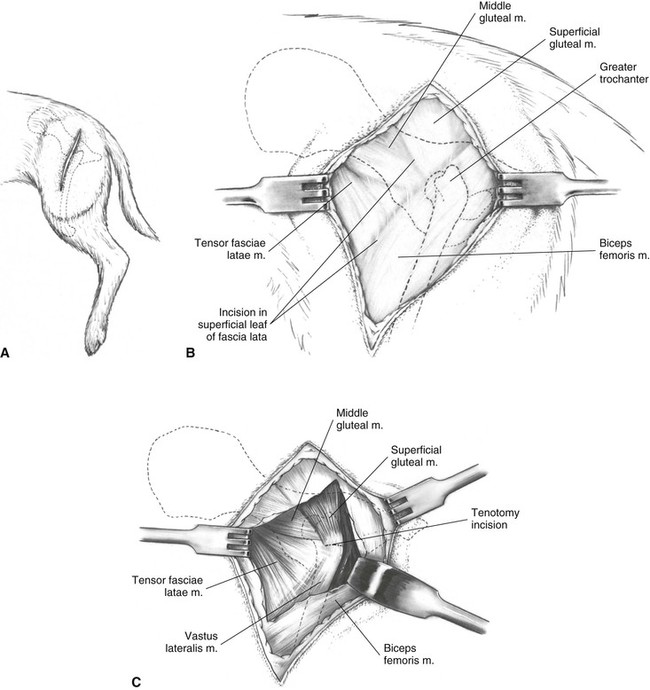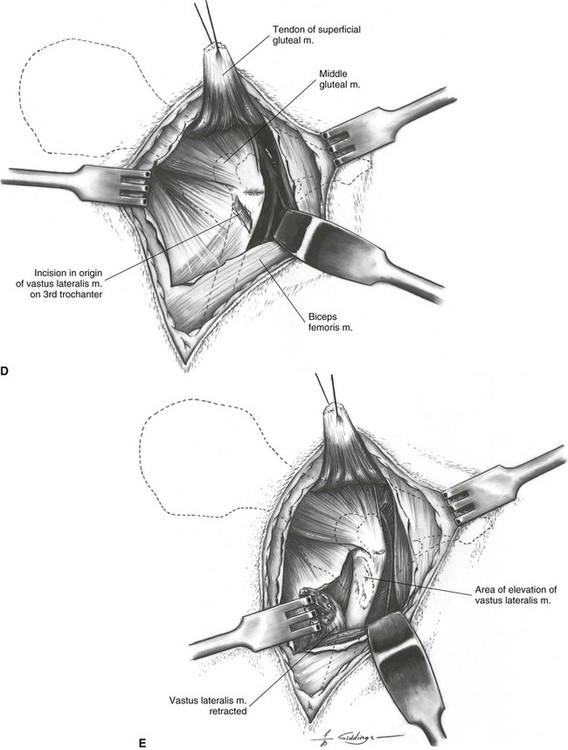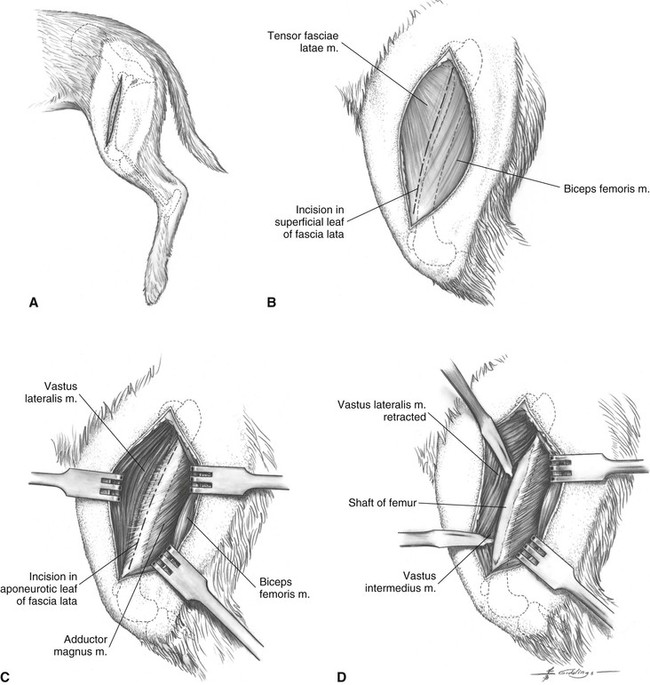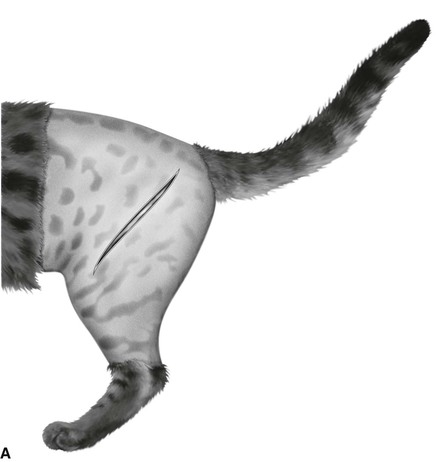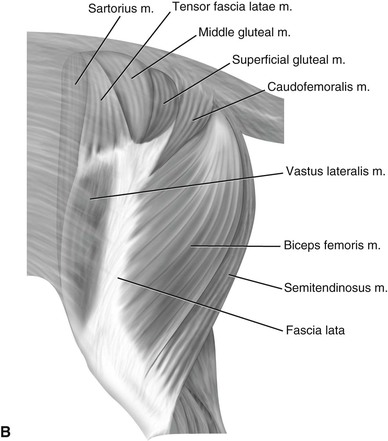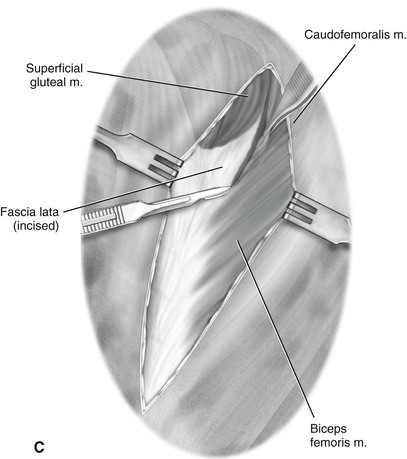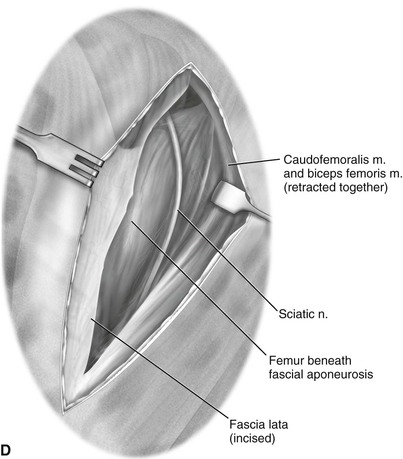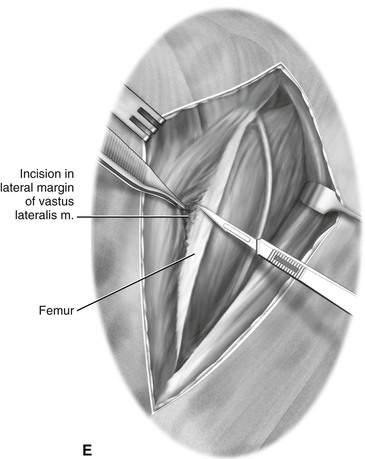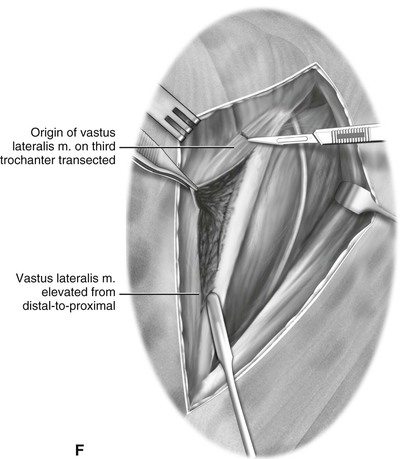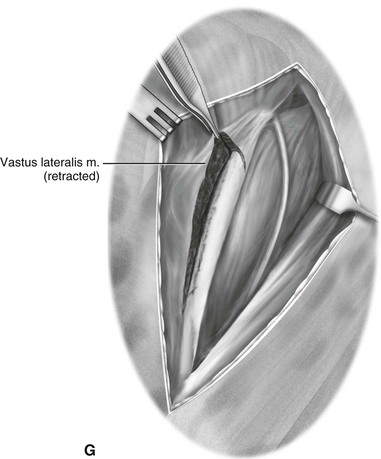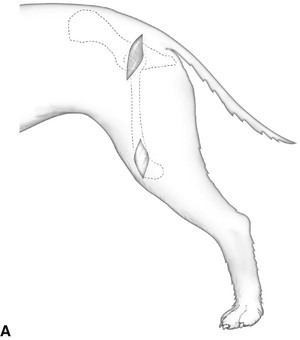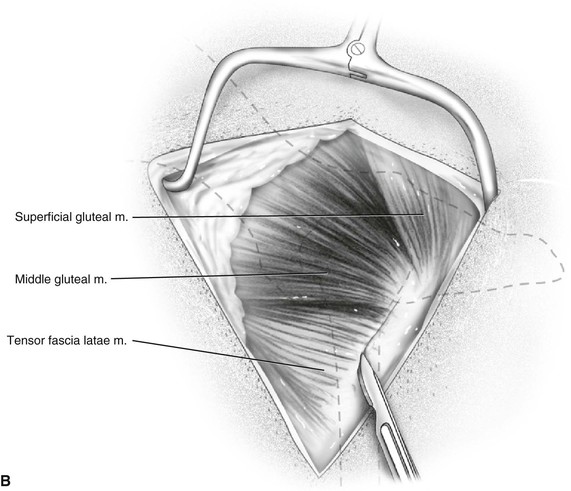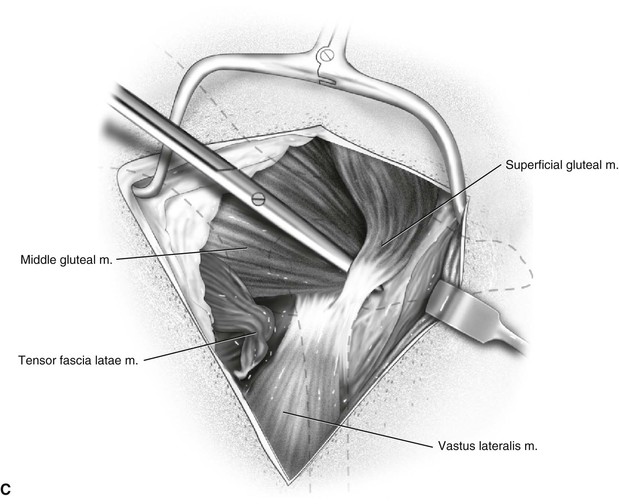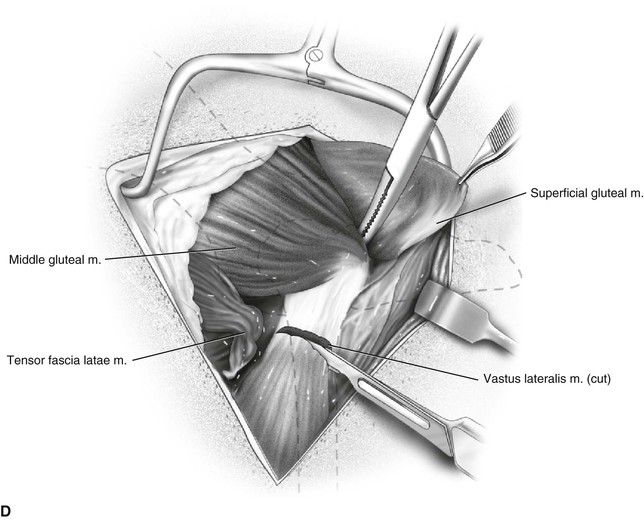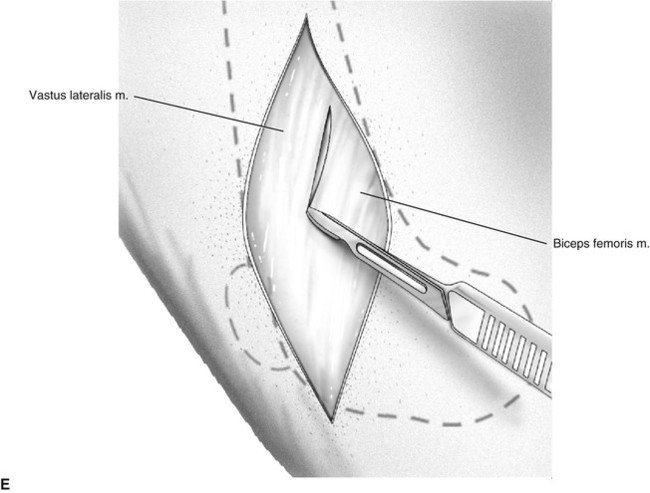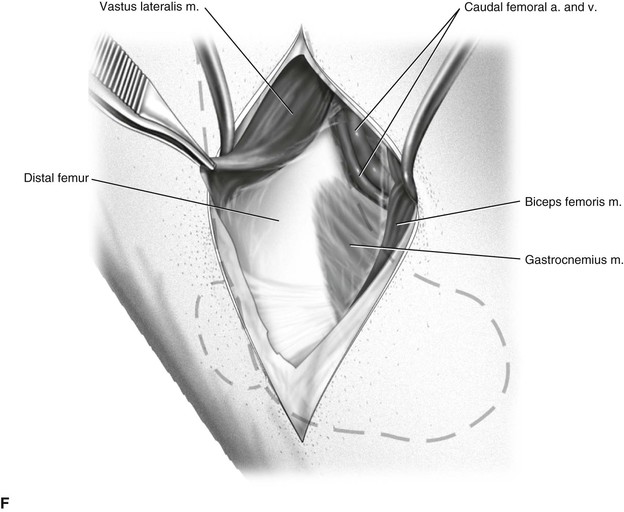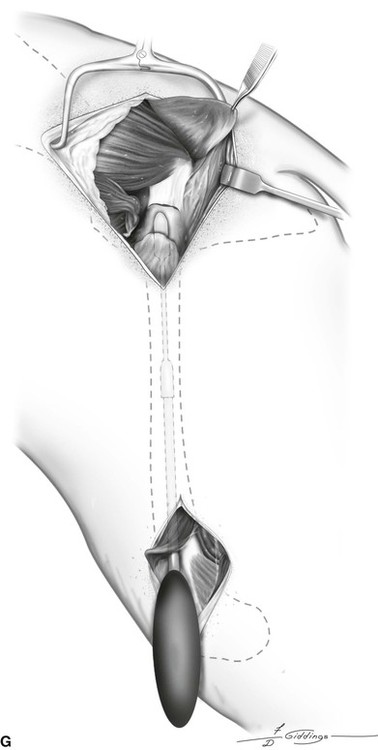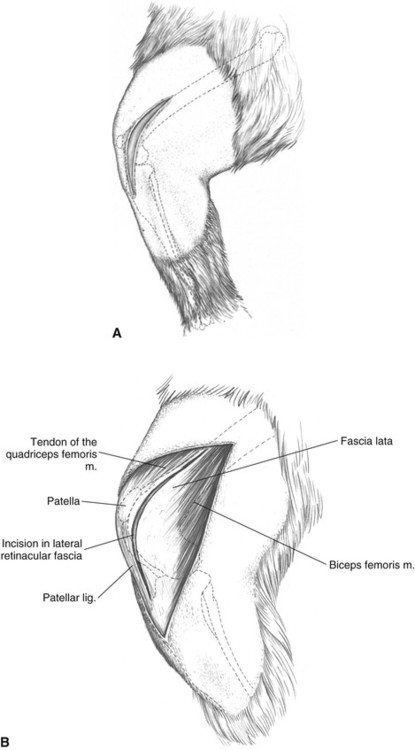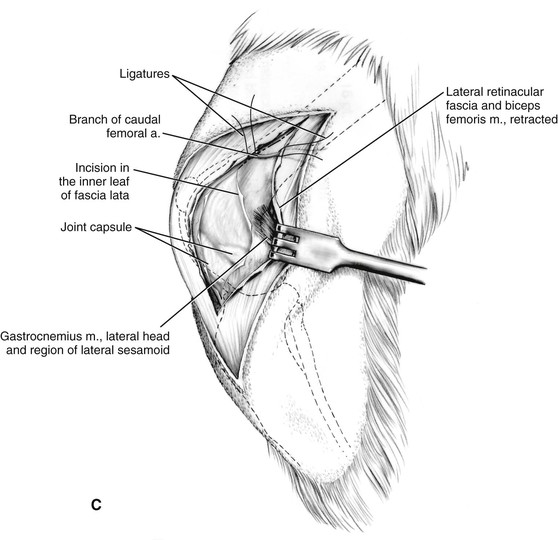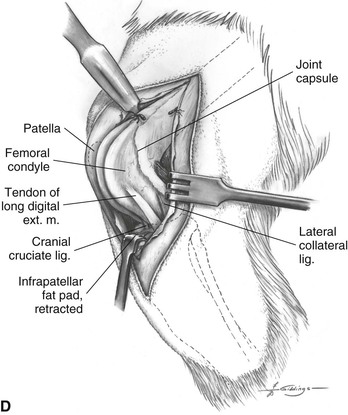The Hindlimb
 . Approach to the Greater Trochanter and Subtrochanteric Region of the Femur
. Approach to the Greater Trochanter and Subtrochanteric Region of the Femur
 . Approach to the Shaft of the Femur in the Dog
. Approach to the Shaft of the Femur in the Dog
 . Approach to the Shaft of the Femur in the Cat
. Approach to the Shaft of the Femur in the Cat
 . Minimally Invasive Approach to the Shaft of the Femur
. Minimally Invasive Approach to the Shaft of the Femur
 . Approach to the Distal Femur and Stifle Joint Through a Lateral Incision
. Approach to the Distal Femur and Stifle Joint Through a Lateral Incision
 . Approach to the Stifle Joint Through a Lateral Incision
. Approach to the Stifle Joint Through a Lateral Incision
 . Approach to the Stifle Joint Through a Medial Incision
. Approach to the Stifle Joint Through a Medial Incision
 . Approach to the Stifle Joint with Bilateral Exposure
. Approach to the Stifle Joint with Bilateral Exposure
 . Approach to the Distal Femur and Stifle Joint by Osteotomy of the Tibial Tuberosity
. Approach to the Distal Femur and Stifle Joint by Osteotomy of the Tibial Tuberosity
 . Approach to the Lateral Collateral Ligament and Caudolateral Part of the Stifle Joint
. Approach to the Lateral Collateral Ligament and Caudolateral Part of the Stifle Joint
 . Approach to the Stifle Joint by Osteotomy of the Origin of the Lateral Collateral Ligament
. Approach to the Stifle Joint by Osteotomy of the Origin of the Lateral Collateral Ligament
 . Approach to the Medial Collateral Ligament and Caudomedial Part of the Stifle Joint
. Approach to the Medial Collateral Ligament and Caudomedial Part of the Stifle Joint
 . Approach to the Stifle Joint by Osteotomy of the Origin of the Medial Collateral Ligament
. Approach to the Stifle Joint by Osteotomy of the Origin of the Medial Collateral Ligament
 . Approach to the Proximal Tibia Through a Medial Incision
. Approach to the Proximal Tibia Through a Medial Incision
 . Approach to the Shaft of the Tibia
. Approach to the Shaft of the Tibia
 . Minimally Invasive Approach to the Shaft of the Tibia
. Minimally Invasive Approach to the Shaft of the Tibia
 . Approach to the Lateral Malleolus and Talocrural Joint
. Approach to the Lateral Malleolus and Talocrural Joint
 . Approach to the Medial Malleolus and Talocrural Joint
. Approach to the Medial Malleolus and Talocrural Joint
 . Approach to the Tarsocrural Joint by Osteotomy of the Medial Malleolus
. Approach to the Tarsocrural Joint by Osteotomy of the Medial Malleolus
 . Approach to the Calcaneus and Plantar Aspects of the Tarsal Bones
. Approach to the Calcaneus and Plantar Aspects of the Tarsal Bones
 . Approach to the Lateral Bones of the Tarsus
. Approach to the Lateral Bones of the Tarsus
 . Approach to the Medial Bones of the Tarsus
. Approach to the Medial Bones of the Tarsus
 . Approaches to the Metatarsal Bones
. Approaches to the Metatarsal Bones
 . Approach to the Proximal Sesamoid Bones
. Approach to the Proximal Sesamoid Bones
Approach to the Greater Trochanter and Subtrochanteric Region of the Femur
Indication
Open reduction of fractures in the trochanteric and subtrochanteric regions of the femur.
Description of the Procedure
A The skin incision runs from a point dorsal and slightly cranial to the trochanter, extends over the lateral surface of the trochanter, and ends distally at the proximal one third of the shaft of the femur.
B The subcutaneous fat and fascia are incised and cleared from the area so that the superficial leaf of the fascia lata can be clearly visualized. An incision is made through the fascia lata along the cranial border of the biceps femoris muscle.
C The biceps is reflected caudally and the skin and fascia lata cranially. The borders of the superficial gluteal muscle are developed by dissection from the surrounding fascia, and the tendon of insertion of this muscle is cut near the femur. Sufficient tendon is left distally to allow suturing at closure.
D The superficial gluteal muscle is retracted proximally to expose the greater trochanter and the middle gluteal muscle. An incision is now made through the fibers of origin of the vastus lateralis muscle along the ridge of the third trochanter of the femur. This incision is deepened to include the periosteum in young animals.
E Subperiosteal elevation of this proximal lateral portion of the vastus lateralis muscle exposes the proximal shaft of the femur. The adductor muscle on the caudal side of the bone can also be elevated from the bone to give additional exposure.
Additional Exposure
Proximally this approach can be extended to combine with either the approach to the craniodorsal aspect of the hip joint through a craniolateral incision (see Plate 66) or the dorsal exposure of the acetabulum using a trochanteric osteotomy (see Plate 69) or gluteal tenotomy (see Plate 70).
Distally this approach can be extended to expose the entire shaft of the femur (see Plate 77).
Precautions
The sciatic nerve emerges from the pelvis under the superficial gluteal muscle, caudal to the deep gluteal muscle. It then passes across the gemelli and internal obturator muscles and down the thigh, under the biceps femoris muscle. To reduce risk of damage to the sciatic nerve, sharp retractors such as the Meyerding should not be used to retract the biceps femoris muscle.
Approach to the Shaft of the Femur in the Dog
Based on a Procedure of Brinker4
Description of the Procedure
A The skin incision is made along the craniolateral border of the shaft of the bone from the level of the greater trochanter to the level of the patella. The subcutaneous fat and superficial fascia are incised directly under the skin incision.
B The skin margins are undermined and retracted and the superficial leaf of the fascia lata is incised along the cranial border of the biceps femoris muscle. This incision extends the entire length of the skin incision. If muscle fibers are encountered, the incision should be directed more cranially.
C Caudal retraction of the biceps femoris reveals the shaft of the femur. It is necessary to incise the fascial aponeurotic septum on the lateral shaft of the bone to adequately retract the vastus lateralis.
D The vastus lateralis and intermedius muscles on the cranial surface of the shaft are retracted by freeing the loose fascia between the muscle and the bone.
Additional Exposure
Proximally this approach can be extended to combine with the approach to the greater trochanter and subtrochanteric region of the femur (see Plate 76).
Distally this approach can be extended to combine with the approach to the distal femur and stifle joint through a lateral incision (see Plate 80).
Precautions
Caudal to the hip joint the sciatic nerve passes across the gemelli and internal obturator muscles. Passing down the caudal thigh under the biceps femoris muscle, it crosses over the quadratus femoris, adductor, and semimembranosus muscles. At about midthigh it branches into tibial and peroneal nerves. To reduce the risk of damage to the sciatic nerve, care should be taken during retraction of the biceps femoris muscle.
Approach to the Shaft of the Femur in the Cat
Description of the Procedure
A The skin incision is made along the craniolateral border of the shaft of the bone from the level of the greater trochanter to the level of the patella. The subcutaneous fat and superficial fascia are incised directly under the skin incision.
B There are several anatomic differences in the musculature surrounding the hip joint and femur in the cat with which the surgeon must be familiar. The gluteal muscles may be relatively larger in the cat than in the dog. Also, the caudofemoralis muscle, a muscle not present in the dog, is interposed between the superficial gluteal and biceps femoris muscles.
C The skin margins are undermined and retracted. An incision is made through the superficial leaf of the fascia lata, along the cranial border of the caudofemoralis and biceps femoris muscles. This incision extends the entire length of the skin incision. If muscle fibers are encountered, the incision should be directed more cranially.
D Caudal retraction of the biceps femoris muscle using an atraumatic retractor, such as a Senn or Langenbeck, reveals the shaft of the femur and the sciatic nerve. It is necessary to incise the fascial aponeurotic septum on the lateral shaft of the bone to adequately expose the vastus lateralis.
E The origin of the vastus lateralis muscle has a firm insertion along most of the shaft of the femur. To gain exposure of the lateral surface of the femur, the lateral margin of the vastus lateralis muscle is sharply incised.
F Using a periosteal elevator, the vastus lateralis muscle is elevated from the shaft of the femur, progressing in a distal-to-proximal direction. For additional exposure proximally, the origin of the vastus lateralis muscle is transected at the third trochanter.
G The vastus lateralis and intermedius muscles on the cranial surface of the shaft are retracted to expose the femoral shaft.
Additional Exposure
Proximally this approach can be extended to combine with the approach to the greater trochanter and subtrochanteric region of the femur (see Plate 76) or the craniodorsal approach to the hip joint (Plate 67D-I).
Distally this approach can be extended to combine with the approach to the distal femur and stifle joint through a lateral incision (see Plate 80).
Minimally Invasive Approach to the Shaft of the Femur
Based on a Procedure of Pozzi and Lewis36
Description of the Procedure
A For this minimally invasive approach to the femur, two skin incisions that are 3 to 5 cm in length are made over the proximal and distal ends of the femur.
B The subcutaneous fat and fascia are incised and retracted to expose the superficial leaf of the fascia lata. An incision is made through the fascia lata along the cranial border of the biceps femoris muscle.
C The borders of the superficial gluteal muscle are developed by dissection from the surrounding fascia, and the tendon of insertion of this muscle on the third trochanter is transected near the femur.
D The superficial gluteal muscle is retracted proximally to expose the greater trochanter and middle gluteal muscle. An instrument is inserted caudal to the middle gluteal muscle and is used to palpate the medial surface of the greater trochanter and the trochanteric fossa. Location of the trochanteric fossa allows subsequent normograde insertion of an intramedullary pin or interlocking nail. The origin of the vastus lateralis is incised to expose the lateral aspect of the proximal region of the femur.
E After identification of the patella and lateral trochlear ridge by palpation, a 2- to 4-cm longitudinal skin incision is made (see Plate 80). The subcutaneous tissue is incised in the same line as the skin incision. An incision is made in the fascia lata along the cranial margin of the biceps femoris muscle.
F Retraction of the biceps femoris muscle caudally and vastus lateralis muscle cranially provides exposure of the distal end of the femur. It may be necessary to ligate and transect the distal branch of the caudal femoral artery and vein. However, the capsule of the stifle joint should not be incised unless there is an indication to gain exposure of this joint.
G A blunt instrument, such as the soft-tissue retractor illustrated here, is passed along the lateral side of the femoral shaft to create an epiperiosteal tunnel.
Closure
The vastus lateralis muscle is reattached to the deep or middle gluteal muscle. Interrupted mattress sutures are used in repair of the tendon of the superficial gluteal muscle. The fascia lata is sutured to the cranial border of the biceps muscle, followed by the subcutaneous fat and fascia in a second layer. Closure of the distal incision begins with suturing of the fascia lata to the biceps femoris muscle in a continuous pattern, followed by the subcutaneous fat and fascia in a second layer.
Approach to the Distal Femur and Stifle Joint Through a Lateral Incision
Based on a Procedure of Paatsama34
Alternative Approaches
Depending on the compartment of most surgical interest, approaches to the stifle can be made via a lateral incision (see Plate 81), medial incision (see Plate 82), bilateral exposure (see Plate 83), or osteotomy of the tibial tuberosity (see Plate 84).
Patient Positioning
Lateral recumbency with the hindlimb suspended for draping, or dorsal recumbency to allow for conversion to bilateral exposure of the joint (see Plate 83 or 84) when required.
Description of the Procedure
A After palpation of the patella and lateral trochlear ridge, a curved parapatellar skin incision is made extending from the tibial tuberosity to the level of the patella, and then an equal distance proximally. The subcutaneous fascia is incised in the same line as the skin incision. The fascia lata and lateral fascia of the stifle joint are exposed by undermining the subcutaneous fat and fascia, which are then retracted with the skin.
B Another curved incision, similar to that in the skin, is made through the fascia lata along the cranial border of the biceps. The incision continues distally into the lateral fascia of the stifle joint. As it crosses the trochlear ridge, it curves to parallel the lateral border of the patella and the patellar ligament. Enough fascia is left on the lateral edge of the patella to receive sutures when the joint is closed.
C The biceps and attached lateral fascia are retracted caudally. In separating the biceps from the vastus lateralis, an intermuscular septum formed from the fascia lata is found attached to the femur. This fascia must be incised to allow mobilization of the quadriceps and biceps. Muscular branches of the distal caudal femoral vessels crossing the distal femur must be ligated in some cases. A parapatellar incision is now made through the joint capsule.
D With the joint extended, the patella and quadriceps can be luxated medially. Lateral retraction of the joint capsule with the biceps and lateral fascia fully exposes the interior of the joint. Incision and retraction of the infrapatellar fat pad may be necessary for inspection of the menisci and cruciate ligaments.
Additional Exposure
Proximally this approach can be extended by combining with the approach to the shaft of the femur (see Plate 77) to expose the entire bone. The muscular branch of the caudal femoral artery that crosses the distal femur to supply the vastus lateralis muscle will need to be ligated. The joint capsule usually need not be incised to expose supracondylar fractures, but it is always incised for exposure of physeal fractures, which are intracapsular.
Closure
The joint capsule and lateral fascia of the stifle joint are closed in one layer with interrupted sutures. Sutures must only be placed in the outer fibrous layer of the joint capsule to prevent suture material from abrading articular cartilage. The fascia lata incision proximal to the patella can be closed with a continuous-pattern suture.
Approach to the Stifle Joint Through a Lateral Incision
Alternative Approaches
Depending on the compartment of most interest, approaches to the stifle can be made via a medial incision (see Plate 82), bilateral exposure (see Plate 83), or osteotomy of the tibial tuberosity (see Plate 84). For cranial cruciate ligament reconstruction the authors favor a medial approach (see Plate 82), particularly in chronic injuries.
Description of the Procedure
A The skin incision starts over the tibial tuberosity lateral to the patellar ligament. It continues proximally to the level of the patella and then an equal distance proximally following the cranial border of the femur (see Comments).
B The arthrotomy incision follows the same line as the skin. The distal portion is made in the lateral fascia first with the scalpel, starting opposite the distal pole of the patella and a few millimeters lateral to the patellar ligament and continuing distally to the tibia. A stab incision is made into the joint at the proximal end of this incision, which will allow entry into the joint with little danger of damaging articular cartilage of the femoral condyle. One blade of a scissor is inserted into the joint and the scissor is advanced proximally, cutting joint capsule, lateral parapatellar fibrocartilage, and fascia lata. As the proximal part of the incision is started, it is directed slightly laterally so as to cut through the vastus lateralis parallel to the muscle fibers and to leave enough tissue on the lateral side of the patella to permit suturing.
C The patella can now be luxated medially. If the patella will not stay in position medially, the proximal end of the incision is lengthened. Distal retraction of the fat pad exposes the cruciate ligaments and menisci.
Additional Exposure
This exposure can be extended proximally for access to the supracondylar region by following the approach shown in Plate 80.
For exposure of the lateral fabella when performing extracapsular stabilization of a cranial cruciate ligament rupture, the approach can be extended caudolaterally as shown in Plate 85C.
Stay updated, free articles. Join our Telegram channel

Full access? Get Clinical Tree


 . Approach to the Calcaneus
. Approach to the Calcaneus . Approaches to the Phalanges and Interphalangeal Joints
. Approaches to the Phalanges and Interphalangeal Joints